In the ever-evolving world of communication, Public Relations (PR) campaigns are the artists’ strokes on the canvas of perception. They wield the power to shape opinions, inspire action, and etch your brand’s image into the public’s mind. But, here’s the enigma: how do you measure the success of this artistic endeavor? Is it in the number of times your name flashes on screens, or is it in the hearts and minds touched by your message? In this exploration of the art and science of PR, we embark on a journey to unveil the elusive metrics that decipher the impact of your campaigns.
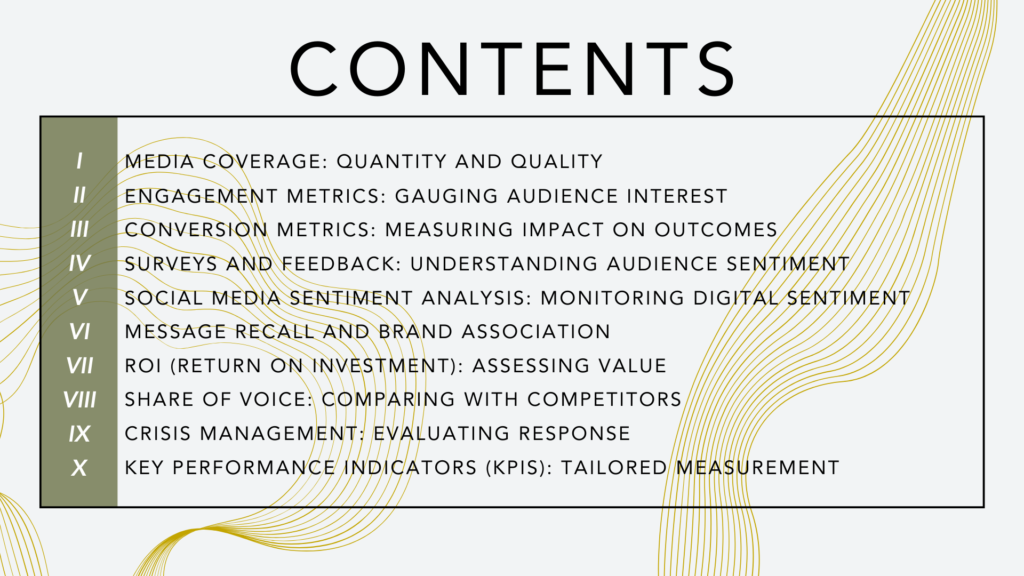
I. Media Coverage: Quantity and Quality
Media coverage serves as the lifeblood of campaigns. The primary goal is not merely to create a buzz but to ensure that your message reverberates far and wide. Measuring the impact of your PR campaign’s media coverage involves a two-fold approach: evaluating the quantity and quality of the mentions your campaign garners.
Quantity of Media Mentions
The quantity of media mentions is often the most straightforward and initial indicator of your campaign’s reach. It essentially answers the question, “How many times did our campaign name or message appear in various media outlets?” A higher number of mentions typically implies a broader reach, as more individuals are potentially exposed to your message.
This metric helps you gauge the extent to which your campaign has permeated the media landscape. However, it’s essential to recognize that quantity alone doesn’t reveal the whole story. In a world of constant information bombardment, capturing attention is a valuable but fleeting victory. Hence, while the quantity of mentions provides an initial snapshot of your campaign’s visibility, it’s the quality of these mentions that truly matters.
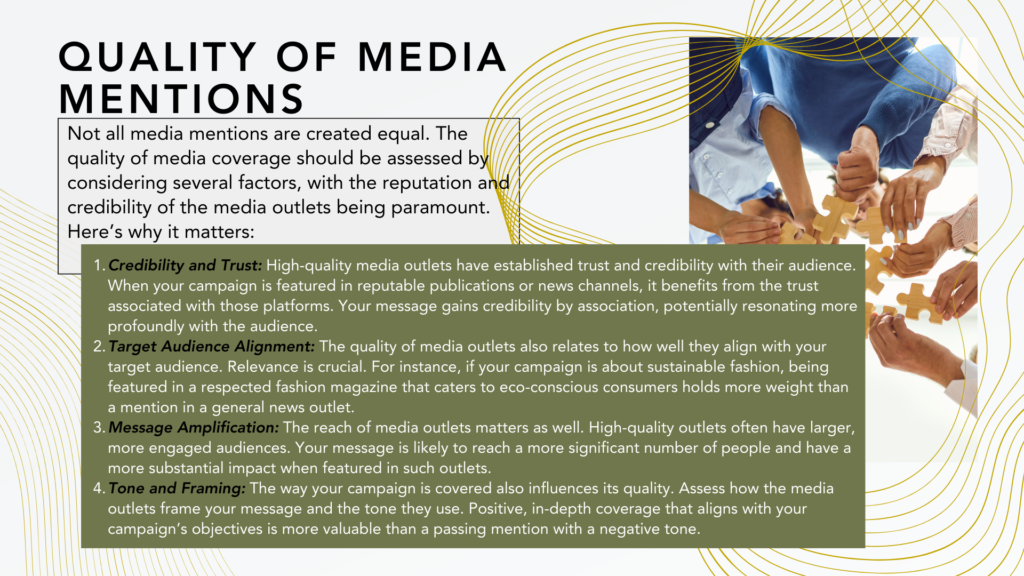
In essence, measuring the quality of media mentions helps you gauge the depth of impact your campaign has achieved. It’s about moving beyond surface-level metrics and understanding how your campaign is perceived and received by the audience. High-quality coverage not only extends your campaign’s reach but also enhances its credibility, fostering a more lasting and positive impression.

Social Media Engagement Metrics
In the digital age, social media platforms have become powerful amplifiers of messages. They are the virtual town squares where ideas are exchanged, trends are set, and conversations unfold. Consequently, these platforms offer a treasure trove of engagement metrics that can provide profound insights into the effectiveness of your PR campaign.
- Likes: The simplest form of engagement, a “like” signifies that someone found your content interesting or appealing. It’s a digital nod of approval that tells you that your message has resonated with the audience on some level.
- Shares: Sharing takes engagement a step further. When someone shares your content, they are not only endorsing it but also exposing it to their own network. It’s a vote of confidence in your message and can significantly expand its reach.
- Comments: Comments are the voice of your audience. They offer direct feedback, questions, and discussions related to your content. Monitoring comments can provide valuable insights into how your audience perceives and interacts with your message.
- Retweets: On platforms like Twitter (now known as “X”), retweets (or whatever the current verb is called) serve a similar function to shares. They signify that someone found your tweet compelling enough to share with their followers, amplifying your message’s reach.
Website Traffic Metrics
While social media engagement is a crucial component, it’s also essential to consider the impact of your PR campaign beyond the confines of social platforms. Your website is often the digital storefront of your brand, and tracking website traffic during and after a PR campaign can reveal the campaign’s influence on your online presence.
- Visits and Page Views: Monitoring the number of visits to your website and the pages viewed during and after a PR campaign can help identify spikes in traffic. If you notice a significant increase in visits during the campaign period, it indicates that your PR efforts are driving people to explore your brand further.
- Bounce Rate: Bounce rate measures the percentage of visitors who navigate away from your website after viewing only one page. A lower bounce rate suggests that visitors are engaging more deeply with your content and exploring multiple pages, potentially indicating a higher level of interest.
- Time on Page: This metric gauges how long visitors stay on a particular page. A longer average time on page can signify that visitors are consuming your content thoroughly, which is often a positive sign of engagement.
- Conversion Rate: While conversion metrics are often categorized separately, they are a crucial part of website traffic analysis. Tracking the conversion rate during a PR campaign helps determine if visitors are taking desired actions, such as signing up for a newsletter or making a purchase.
Engagement metrics on social media and website traffic metrics collectively paint a picture of how your (digital) PR campaign is resonating with your target audience. They offer a window into the effectiveness of your messaging, the level of interest it generates, and the extent to which it drives interactions and actions. Monitoring these metrics in real-time and over time allows for data-driven adjustments and refinements to optimize the impact of your PR efforts.
III. Conversion Metrics: Measuring Impact on Outcomes
In specific cases, PR campaigns aim to drive particular actions, such as sign-ups, downloads, or purchases. The ultimate litmus test of a successful PR campaign often lies in its ability to drive these specific actions from the target audience. Whether you’re seeking to increase newsletter sign-ups, encourage app downloads, or stimulate product purchases, the conversion metrics come into play as the spotlight on your campaign’s efficacy.


The Significance of Conversion Metrics for ROI Assessment
Conversion metrics hold a pivotal role in the broader context of Return on Investment (ROI) assessment. In a world where every dollar spent on PR campaigns must be justified, these metrics provide a direct line of sight to the financial impact of your efforts.
Consider the resources invested in your PR campaign, from manpower to media placements. To determine if those investments are yielding a positive return, you need to measure not only the reach and engagement but also the conversion rates. Are your campaigns not only capturing attention but also translating that attention into revenue? Conversion metrics furnish the answer.
Fine-Tuning Your PR Strategy
Conversion metrics do more than just provide a post-campaign report card; they also serve as a tool for real-time optimization. By closely monitoring conversion rates during your campaign, you can identify potential bottlenecks or barriers that hinder your audience from taking the desired actions.
For instance, if you observe a high bounce rate on your sign-up page, it may signal that your call-to-action needs refinement or that your audience needs more compelling incentives to convert. Armed with this insight, you can make necessary adjustments mid-campaign to ensure that your PR efforts stay on course to achieve your objectives.
Conversion metrics are not mere statistics; they are the navigational beacons guiding your PR campaign towards success. They provide the tangible evidence of your campaign’s ability to influence audience behavior and contribute to the bottom line. In the intricate dance of public relations, conversion metrics are the choreographers ensuring that every move leads to a standing ovation of conversions and, ultimately, a positive ROI.
IV. Surveys and Feedback: Understanding Audience Sentiment
Direct feedback from the target audience can offer invaluable insights into a campaign’s effectiveness. Understanding audience sentiment is like deciphering the secret code to success. While quantitative metrics like media mentions and website traffic provide essential insights, there’s a profound layer of understanding that can only be reached through direct feedback from your target audience.
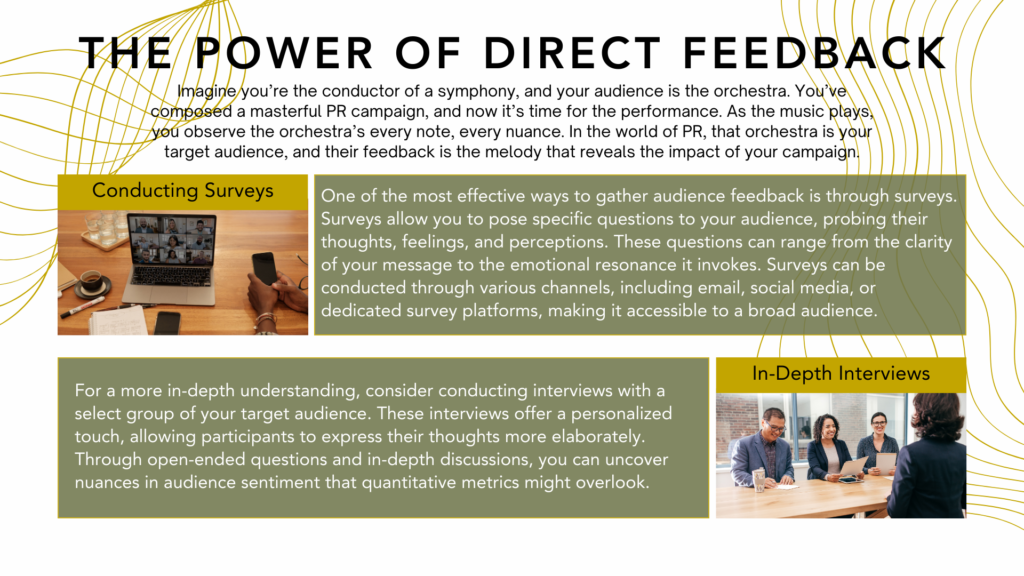
Gauging Audience Perception and Sentiment
The aim of these surveys and interviews is to decode audience perception and sentiment. Quantitative data tells you “what” – how many people engaged with your campaign or visited your website. But qualitative data, acquired through surveys and interviews, tells you “why” – why they engaged, what emotions your campaign stirred, and what they remember most.
For instance, you may discover that while your campaign generated significant media buzz, it failed to resonate emotionally with your target audience. Alternatively, you might find that a particular aspect of your message deeply resonated with your audience, leading to a positive shift in sentiment toward your brand. These insights go beyond the surface-level numbers, providing a richer understanding of your campaign’s impact.
The Deeper Understanding
In the realm of PR, numbers tell only part of the story. They provide the “what” and the “how many,” but the true essence of your campaign’s impact lies in the “why” and “how.” Why did your audience engage with your message, and how did it make them feel? These are questions that surveys and interviews help answer.
This deeper understanding of audience sentiment not only informs the evaluation of your current campaign but also lays the groundwork for future PR strategies. Armed with insights into what resonates with your audience and what falls flat, you can fine-tune your messaging and tactics for even greater success in the future.

The Power of Sentiment Analysis
Enter sentiment analysis, a formidable tool in the PR arsenal. Sentiment analysis, also known as opinion mining, is the process of computationally evaluating and categorizing opinions, emotions, and attitudes expressed in textual data. When applied to social media, it becomes a dynamic way to gauge how people are reacting to your PR campaign. By harnessing the power of sentiment analysis, PR practitioners can decipher the nuances of public sentiment—whether it’s positive, negative, or neutral—toward their brand, message, or campaign.
Categorizing Sentiment
The essence of sentiment analysis lies in categorization. Through sophisticated algorithms and natural language processing, sentiment analysis tools can assess the tone and context of social media mentions. These mentions are then categorized into one of three primary sentiments:
- Positive Sentiment: These mentions convey approval, enthusiasm, or support for your campaign. Positive sentiment can signify that your message is resonating with your target audience and generating goodwill.
- Negative Sentiment: Negative mentions indicate dissatisfaction, criticism, or disapproval. Identifying negative sentiment is crucial for crisis management and addressing issues promptly.
- Neutral Sentiment: Neutral mentions are neither overwhelmingly positive nor negative. They often reflect factual statements or observations without strong emotional tones.
The Value of a Snapshot
The true power of social media sentiment analysis lies in the ability to capture a snapshot of public sentiment at a given moment. This snapshot provides real-time insights into how your campaign is being perceived. Are your efforts sparking joy and positive conversations, or are they inadvertently causing backlash and negative reactions? With sentiment analysis, you don’t have to rely solely on anecdotal evidence or hunches. Instead, you can make data-driven decisions to adjust your PR strategy as needed.
Enabling Timely Adjustments
The timeliness of social media sentiment analysis is one of its most invaluable aspects. It allows PR professionals to make adjustments to their campaigns in near real-time. For instance, if a campaign is generating unexpectedly negative sentiment, immediate action can be taken to address concerns, clarify messaging, or pivot the strategy altogether. Conversely, if a campaign is sparking positive sentiment, efforts can be amplified to capitalize on the momentum.
VI. Message Recall and Brand Association
Beyond mere exposure, a successful PR campaign should ensure that your key messages are remembered and associated with your brand. Assessing message recall can be accomplished through surveys, focus groups, or interviews. Simultaneously, measuring the campaign’s impact on brand association involves evaluating whether your messages align with the desired brand image.

- Surveys: Conducting surveys post-campaign is a common approach. These surveys can be designed to directly ask participants about specific campaign messages. Respondents are questioned about what they remember from the campaign, allowing you to gauge which messages left a lasting impression.
- Focus Groups: In a focus group setting, participants engage in discussions about their perceptions of the campaign. This qualitative approach provides deeper insights into which aspects of the campaign messages resonated most strongly and why.
- Interviews: One-on-one interviews with a cross-section of your target audience can yield rich insights into message recall. These interviews can delve into individual experiences and thought processes, shedding light on what messages stood out and why.
The aim of assessing message recall is to determine which aspects of your campaign messaging were memorable to the audience. It helps identify strengths and weaknesses in your messaging strategy, allowing for refinement in future campaigns.

- Consistency with Brand Values: Analyze whether the campaign messages align with the core values and identity of your brand. Do they reinforce the desired image you want to project to the public?
- Perceived Brand Attributes: Assess whether the audience associates your brand with specific attributes or qualities that were highlighted in the campaign. Did the campaign successfully shape the perception of your brand?
- Customer Sentiment: Monitor customer sentiment to determine if the campaign positively influenced how your audience feels about your brand. Did it foster a more favorable view of your organization?
- Market Research: Utilize market research techniques to gauge changes in brand perception before and after the campaign. Have there been shifts in how your brand is perceived within the marketplace?
Brand association is a crucial dimension of PR campaign measurement, as it reflects the enduring impact of your efforts. While immediate message recall is valuable, the long-term goal is to ensure that these remembered messages contribute positively to your brand’s image and reputation.
VII. ROI (Return on Investment): Assessing Value
Public Relations campaigns are often seen as investments aimed at generating positive outcomes for businesses and organizations. Whether your goal is to boost brand awareness, promote a new product, or manage a crisis, it’s essential to assess the tangible returns on your PR investments.
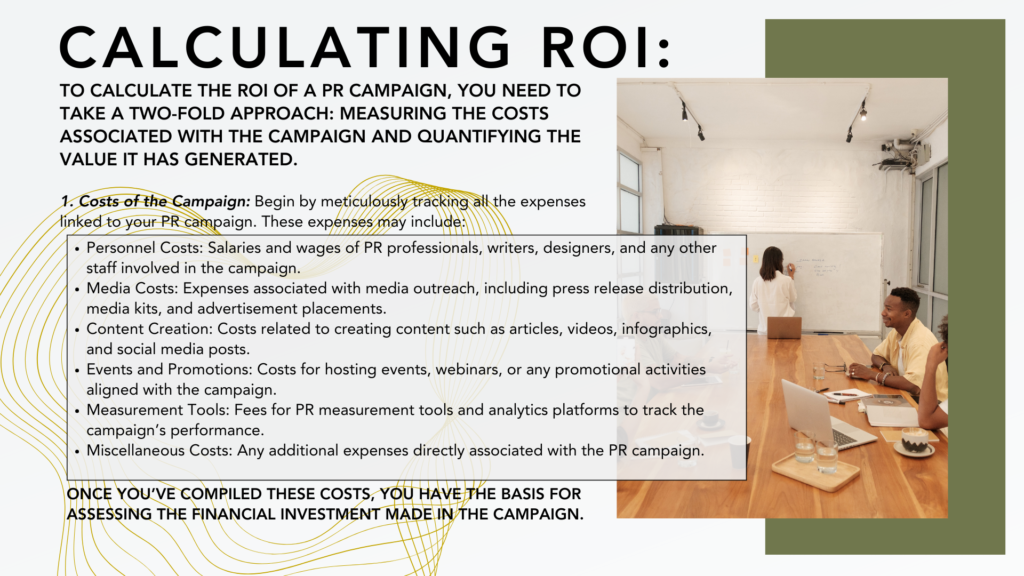
2. Value Generated: The second facet of ROI measurement revolves around quantifying the value generated by the PR campaign. This value can take various forms, and it’s crucial to tailor your evaluation to the campaign’s specific goals. Here are some common ways to gauge the value generated:
- Increased Revenue: Determine if the PR campaign has led to a noticeable uptick in sales or revenue. Analyze sales data during and after the campaign to identify any spikes.
- Enhanced Brand Equity: Assess whether the campaign has positively influenced the perception of your brand in the eyes of your target audience. This can be measured through surveys, brand sentiment analysis, and focus groups.
- Lead Generation: If the campaign’s objective was to generate leads, calculate the number of leads acquired and their potential value over time.
- Web Traffic and Conversions: Analyze the increase in website traffic attributable to the campaign and measure conversions, such as sign-ups, downloads, or purchases resulting from that traffic.
- Media Exposure: Assign a value to the media exposure the campaign garnered. This can be based on advertising equivalency or media monitoring tools that estimate the cost of equivalent advertising space.
- Social Media Metrics: Evaluate the impact on your social media metrics, such as follower growth, engagement rates, and click-through rates on campaign-related posts.
By comprehensively assessing these factors, you can arrive at a clearer picture of the value generated by your PR campaign.

VIII. Share of Voice: Comparing with Competitors
In the bustling marketplace of ideas and information, where every brand and organization vies for attention, your “share of voice” is a metric of paramount significance. This term, often shortened to SOV, doesn’t just denote how loudly you’re speaking but how effectively your voice stands out amid the cacophony of your competitors.

Why Share of Voice Matters
Share of voice is crucial for several reasons:
- Visibility: The more you’re heard, seen, or read, the more visible your brand becomes. In a world where attention spans are fleeting, being omnipresent is a powerful way to stay top-of-mind.
- Competitive Analysis: Share of voice is at its most potent when compared to your competitors. By analyzing how much of the conversation your brand commands in comparison to others in your industry or niche, you gain invaluable insights. Are you the dominant player, or are you an underdog striving to rise? This comparative analysis helps you understand your brand’s position within the market.
- Brand Authority: A larger share of voice often correlates with enhanced brand authority. It signifies that your audience sees you as a credible source of information and opinions in your field.
Measuring Share of Voice
Measuring your share of voice entails tracking your brand’s mentions across various media channels. This includes counting the number of times your brand is featured in articles, social media posts, television segments, and more. However, it’s not just about the quantity; it’s also about the context and sentiment surrounding these mentions.
To gain a comprehensive view of your share of voice, you can use media monitoring and sentiment analysis tools. These tools not only quantify your mentions but also categorize them as positive, negative, or neutral. This distinction is vital because a significant share of voice can be undermined if the sentiment is predominantly negative.
Leveraging Share of Voice
Once you’ve measured your share of voice, the next step is to leverage it effectively. A larger share of voice can be a potent asset for your PR strategy:
- Identify Opportunities: By understanding where you stand in the market, you can identify opportunities for growth and improvement. Are there gaps in the conversation that your brand can fill? Are there areas where you can outshine your competitors?
- Enhance Visibility: If your share of voice is smaller than you’d like, it’s a call to action. Invest in strategies to increase your presence in the media landscape. This could involve creating more compelling content, engaging with journalists and influencers, or running targeted PR campaigns.
- Shape Perceptions: Remember, share of voice isn’t just about quantity; it’s about the quality of your voice. Use your presence to shape the narrative and influence how your audience perceives your brand. Be consistent in your messaging and ensure that it aligns with your overall PR goals.

The Crucial Role of Crisis Management in PR
Crisis management is the art of navigating turbulent waters. It’s about maintaining not only your organization’s reputation but also the trust and confidence of your stakeholders during challenging times. PR campaigns often shift gears from proactive promotion to reactive crisis resolution, and how effectively this transition is managed can significantly impact the outcome.
Evaluating the Effectiveness
Assessing the effectiveness of a crisis management PR campaign involves several key considerations:
- Speed of Response: Time is of the essence in crisis management. The speed with which your organization acknowledges and responds to a crisis can be a game-changer. A swift and decisive response can help contain the situation and prevent it from escalating. The delay, on the other hand, can intensify public scrutiny and magnify the damage.
- Public Perception: The court of public opinion can be both your ally and your adversary during a crisis. Monitoring public sentiment and perception is crucial. Are people viewing your response as transparent, empathetic, and responsible? Or is it seen as evasive, insincere, or dismissive? Analyzing public sentiment on social media and other platforms provides valuable insights into how your response is resonating.
- Legal and Regulatory Outcomes: In some crises, legal and regulatory implications loom large. The success of a crisis management PR campaign can be measured by how well it navigates these aspects. Are legal issues being addressed promptly and effectively? Are regulatory requirements being met? Avoiding legal pitfalls and regulatory penalties is a clear indicator of a well-managed crisis response.
- Resolution and Reconciliation: Ultimately, the goal of crisis management is resolution and reconciliation. Measuring success includes assessing whether the crisis has been resolved satisfactorily and whether steps have been taken to rebuild trust and relationships with stakeholders.
The Power of Learning from Crises
In the world of PR, crises can often serve as powerful learning opportunities. An adept crisis management team will not only focus on immediate resolution but will also conduct a postmortem analysis. What went well? What could have been handled differently? What lessons can be drawn from the crisis to strengthen future PR campaigns?
X. Key Performance Indicators (KPIs): Tailored Measurement
Establishing specific KPIs aligned with your campaign’s objectives is fundamental. Whether your goal is to increase brand awareness, launch a new product, or manage a crisis, your KPIs should be tailored to align with these specific objectives. Customized KPIs ensure that your measurement strategies are in sync with your campaign’s purpose.

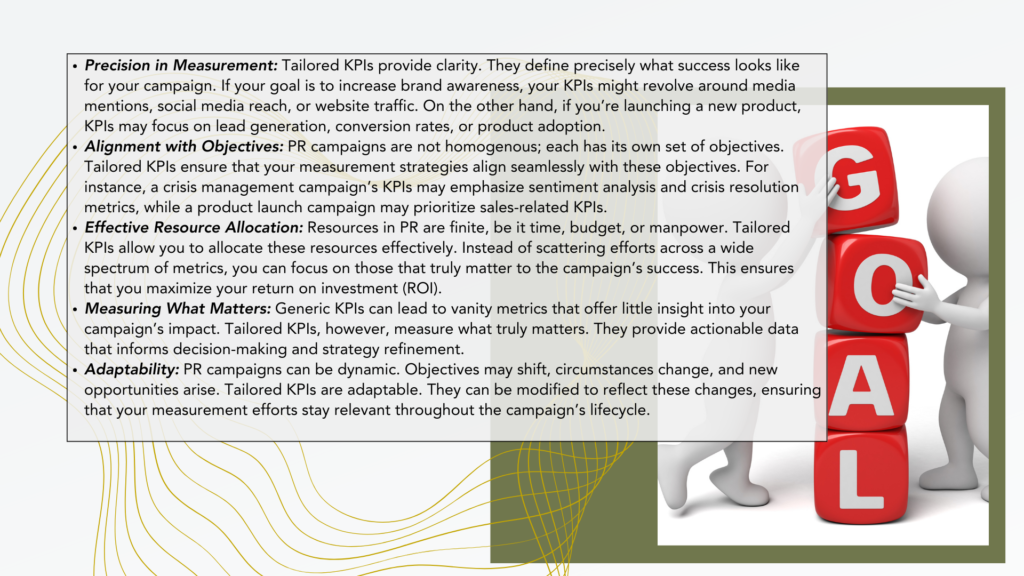
Crafting Tailored KPIs
Crafting tailored KPIs requires a deep understanding of your campaign’s goals and the audience you aim to engage. Here’s a step-by-step approach to creating effective, customized KPIs:
- Define Clear Objectives: Start by defining the overarching objectives of your PR campaign. Are you aiming to boost brand awareness, manage a crisis, or achieve another specific goal? Clarity in objectives is the foundation of effective KPIs.
- Identify Key Outcomes: For each objective, identify the key outcomes that would signify success. What does success look like? For a brand awareness campaign, outcomes might include media mentions, social media engagement, or increased website traffic.
- Make Them Measurable: Ensure that your KPIs are quantifiable. They should be expressed in numbers or percentages, allowing you to track progress and measure success objectively.
- Set Realistic Targets: Define what success means in terms of your KPIs. What are the specific targets you aim to achieve? Realistic targets provide a benchmark against which you can assess your performance.
- Continuously Monitor and Adjust: KPIs are not static; they should evolve alongside your campaign. Continuously monitor your progress and be prepared to adjust your KPIs if the campaign’s circumstances change or if new opportunities emerge.
As the dust settles on the metrics and measures, we are left with a question that resonates in the corridors of PR: can you truly put a number on perception? Perhaps, but remember, every digit in your analytics report represents a heartbeat, a thought, a choice. So, ask yourself, as you measure success in numbers and data, what do those figures truly reflect? In the realm of PR, are we counting numbers, or are we counting on hearts and minds?
